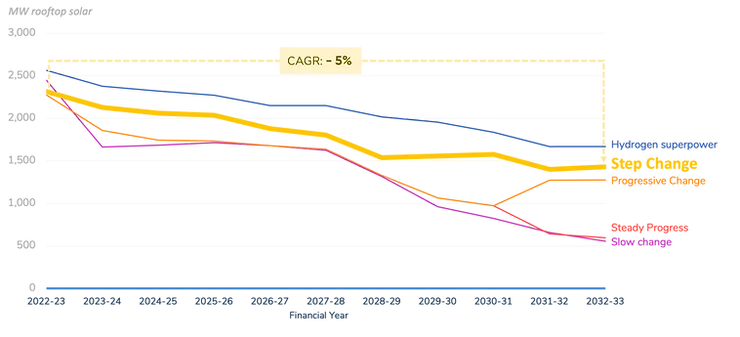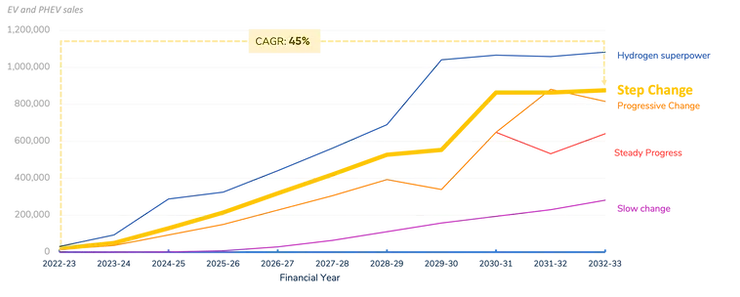Blog /
Industry Insights
Memo to solar installers: get diversifying - the Australian solar market is predicted to contract
September 9, 2022
If you plan to grow a solar business in Australia, you must have a solution for batteries, EVs and other new energy technology. Why? Because the best forecasts on the rooftop solar market show it is going to start contracting. The CSIRO and Green Energy Markets forecast that the compound annual growth rate for solar in Australia will be -5% p.a. over the next decade, even under the most ambitious scenarios.
Correspondingly, behind-the-meter batteries are expected to grow by 18% p.a. and EV and PHEV sales by 45% p.a. in Australia over the next decade.
The Australian rooftop solar market is going to contract
The chart below (Figure 1) shows that even under the most aggressive scenarios, the rooftop solar market is expected to contract. This is due to falling government incentives and the fact that a fair amount of the low-hanging fruit in the market has already been picked. Today, 30% of detached homes in the Australian National Electricity Market already have solar on the roof, a staggering 15GW already installed (go Team Solar!). But the solar penetration is expected to peak at around 65% to account for rentals and unsuitable roofs. Looking at those figures, nearly half of the solar market is satisfied. (That said, AEMO also predicts that by 2050 there will be 69GW of rooftop solar installed in Australia, so it is also expected that many homes and businesses will increase their system sizes.)
Note that while we can't fault the long-term trend, these curves don't take into consideration some short-term impacts that were not considered at the time these forecasts were prepared (2021). Notably, the forecasts don't account for the recent and ongoing energy market turbulence caused by high gas prices and Russia's war in Ukraine - this factor alone will likely briefly turbo-charge the solar market but this will bring forward installations rather than create new opportunities.

Figure 1: Forecast rooftop PV deployment in megawatts (MW) per annum, FY22 – FY32, Source: 2022 ISP Input and assumptions workbook, AEMO.
But the Australian battery market and EV markets are expected to grow rapidly
Figures 2 and 3 show the expected battery and EV market growth under various energy market scenarios. All except Slow Change predict the battery market will grow. The most likely scenario is Step Change which corresponds to a compound annual growth rate for batteries in Australia of 18% p.a. and 45% p.a. for EV and PHEV sales.
These trends are being driven by the falling technology prices and install costs, increasing energy market volatility and therefore improving battery economics.

Figure 2: Forecast embedded (behind-the-meter) battery deployment in megawatts (MW) per annum, FY22 – FY32, Source: 2022 ISP Input and assumptions workbook, AEMO.

Figure 3: Forecast EV and PHEV sales per annum, FY23 – FY33, Source: 2022 ISP Input and assumptions workbook, AEMO.
What does this mean for solar installers?
Solar installers that don’t wish to be locked into a race to the bottom in the solar market will need to diversify their businesses into batteries, EV chargers and other new energy technologies. The good news is that most solar installers already have a relationship with customers that will be prime candidates for these technologies.
Further to this, battery companies need to be selling batteries with the full potential value stack in mind. To that end, understanding the benefits of and developing a battery offering that includes virtual power plant integration and revenue streams will be a critical success factor. The smart companies will likely establish their own VPPs and find new revenue opportunities through the ongoing management of solar and batteries.
Naturally, the modelling requirements for batteries are orders of magnitude more complex, which is why we developed Orkestra. Book a demo today to see how we can support you to sell batteries.
A final note on the scenarios in the charts.
These scenarios are from the Australian Energy Market Operator’s Integrated System Plan (AEMO ISP). Among other things, they correspond to various climate target ambitions as per the Paris Climate Agreement. Hydrogen superpower corresponds to 1.5ºC warming, Step Change - 2.0ºC (most closely aligned to the current Albanese Government policy), Progressive Change - 2.6ºC (aligned to the Morrison Government policy), Steady Progress - 2.6ºC and Slow Change - 4.0ºC. Most energy industry experts, including Orkestra, believe that the Step Change scenario is the most likely.
About James Allston and Orkestra
James Allston is the Co-founder and Chief Commercial Officer of Orkestra. James is an energy nerd and analyst at heart, regularly writing on the topics of new energy technology, markets and regulation. James and his team are developing Orkestra which is rapidly becoming Australia's leading feasibility and sales support SaaS tool for commercial and industrial solar, battery and VPP projects.

